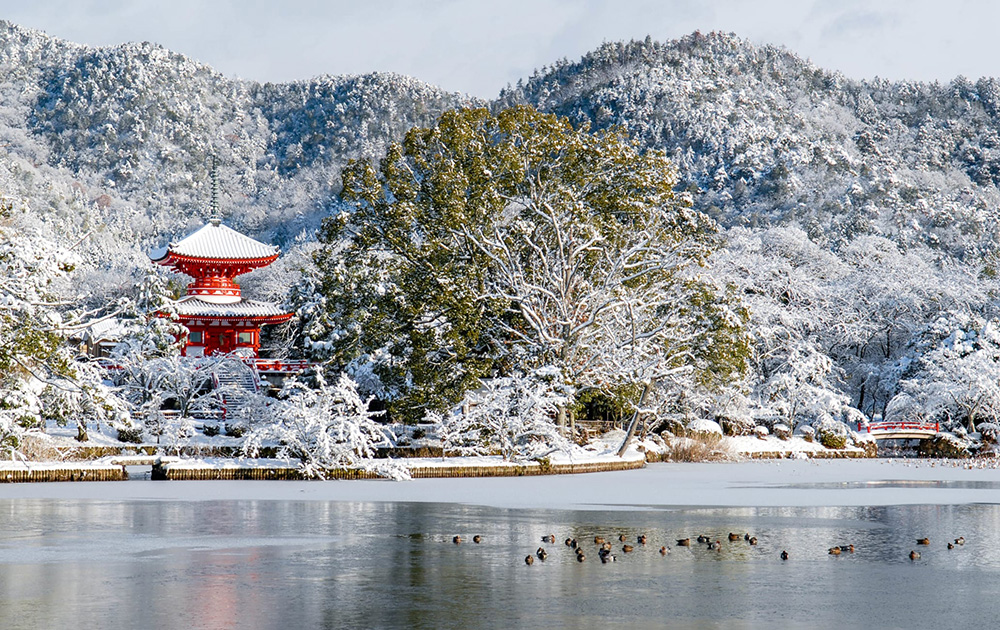Introduction
Daikakuji Temple, located in the northern part of Kyoto’s Sagano district, is a grand and historically significant temple. Originally built in the early 9th century as a detached palace for Emperor Saga, it was later converted into a temple. As one of the most important temples of Shingon Buddhism in Japan, Daikakuji not only preserves precious historical artifacts but also offers visitors a glimpse into the atmosphere of ancient imperial courts.
Key Highlights
- Former imperial villa converted into a temple, rich in historical significance
- Important Shingon Buddhist temple with a strong cultural atmosphere
- Well-preserved Heian period architecture, exemplifying ancient imperial building styles
- Historic Osawa Pond garden, Japan’s oldest surviving Shinden-style garden
- Precious Buddhist artifacts and artworks, including the Heart Sutra handwritten by Emperor Saga
- Beautiful scenery throughout the four seasons, especially cherry blossoms in spring and autumn foliage
Deep Historical Roots
Daikakuji was established in 814 CE as Emperor Saga’s detached palace. Thirty years after the emperor’s death, it was converted into a temple, becoming an important center for Shingon Buddhism. Throughout Japanese history, Daikakuji has played several significant roles:
- Residence for numerous retired emperors, making it a political center during the Heian period
- Hosted peace talks in the 12th century that reunited the Northern and Southern Imperial Courts
- Featured in “The Tale of Genji,” Japan’s first novel and a landmark in Japanese literature
- Continues to be an excellent place to experience the atmosphere of ancient imperial courts, often used as a filming location for historical dramas
Main Attractions
Heart Sutra Hall
The Heart Sutra Hall is an octagonal building housing one of Daikakuji’s most important treasures – the Heart Sutra handwritten by Emperor Saga. Legend has it that this precious scripture, completed under the guidance of Kobo Daishi (Kukai), once resolved a mysterious plague during the Heian period. Due to its significance, this artifact is only displayed once every 60 years.
Reihokan Museum
The Reihokan is a small museum that hosts special exhibitions in spring and autumn, showcasing the temple’s treasures. These exhibits include ancient calligraphy, paintings, and Buddhist artifacts, offering visitors insight into the essence of Japanese Buddhist art.
Osawa Pond
Osawa Pond is a 1200-year-old man-made lake, the oldest surviving example of a Shinden-style garden. Initially built for Emperor Saga’s detached palace, it was used for grand court banquets and leisure activities such as boating, fishing, and moon viewing.
The current garden landscape around Osawa Pond includes:
- Several Buddhist statues showcasing Buddhist art
- A small shrine, reflecting the fusion of Shinto and Buddhist practices
- The Shingyo Pagoda, commemorating the 1150th anniversary of Emperor Saga’s transcription of the Heart Sutra
- Walking paths connecting various points of interest
Osawa Pond is particularly beautiful during cherry blossom season in spring and autumn foliage season.
Shingyo Pagoda
The Shingyo Pagoda is a two-tiered tahoto-style structure built to commemorate the 1150th anniversary of Emperor Saga’s transcription of the Heart Sutra. Its elegant form exemplifies traditional Japanese architectural artistry.
Other Buildings
Daikakuji consists of several buildings connected by elevated wooden walkways. These corridors, similar to the “nightingale floors” of Nijo Castle’s Ninomaru Palace, squeak quietly as you walk over them. Many buildings are decorated with painted sliding doors (fusuma) by the famous Kano school, showcasing high artistic value.
Best Time to Visit
- Spring (late March to early April): Cherry blossoms in full bloom around Osawa Pond
- Autumn (late November): Brilliant fall foliage surrounds the temple
- Summer (June-August): A cool retreat with lush greenery
- Winter (December-February): Occasional snowfall creates a serene, snow-covered landscape
Detailed Access Guide
- From Kyoto Station:
- Take the JR San’in Main Line (15 minutes, 240 yen) to JR Saga-Arashiyama Station, then walk 15 minutes
- Or take bus number 91 from JR Saga-Arashiyama Station (5 minutes, 230 yen, every 20 minutes)
- From Arashiyama area:
- 25-minute walk from Keifuku Arashiyama Station
- Or take bus number 28 (10 minutes, 230 yen, every 20 minutes)
- By car:
- Parking available but limited; best to confirm in advance
- By taxi:
- About 40 minutes from Kyoto Station, fare approximately 5000-6000 yen
Hours and Admission Fees
- Hours: 9:00 AM to 5:00 PM (last entry at 4:30 PM)
- Open year-round
- Admission:
- Temple: 500 yen
- Osawa Pond Garden: 300 yen
- Combination ticket: 700 yen (recommended)
Visitor Tips
- Wear comfortable shoes for walking on wooden corridors and around the grounds
- Visit the Reihokan Museum’s special exhibitions in spring and autumn
- Allow 2-3 hours for a thorough exploration of all sites
- Photographers should bring wide-angle lenses for capturing Osawa Pond’s scenery
- Maintain a respectful quiet during your visit, honoring the temple’s religious atmosphere
- Consider purchasing omamori (protective charms) or participating in sutra copying
- Try local cuisine at nearby traditional Japanese restaurants
- If time allows, combine your visit with nearby attractions like Tenryuji Temple and the Bamboo Grove
Nearby Attractions
- Tenryuji Temple: About 1 km away, a famous Zen temple
- Arashiyama Bamboo Grove: Near Tenryuji, an iconic Kyoto landscape
- Togetsukyo Bridge: Famous sightseeing spot overlooking the Katsura River
- Nonomiya Shrine: A small, charming shrine known for its black torii gate
Official Website
Conclusion
Daikakuji Temple is an unmissable historical gem in Kyoto, combining imperial palace architecture, Buddhist temple traditions, and Japanese garden design. It serves not only as a window into Japanese history and culture but also as a sanctuary for relaxation and natural beauty. Whether you’re a history enthusiast, Buddhist devotee, garden lover, or photography buff, Daikakuji offers a unique and unforgettable experience.
Visit Daikakuji to hear the echoes of a thousand years of history, experience the essence of Japanese culture, and allow your spirit to be purified and uplifted in this ancient temple. This Kyoto journey will surely make Daikakuji one of your most treasured memories.
